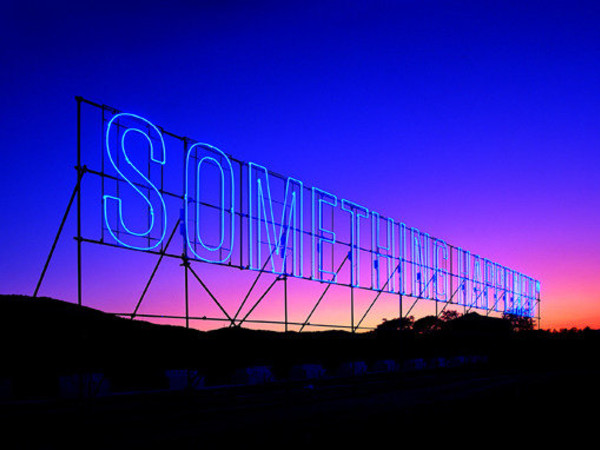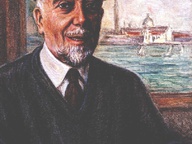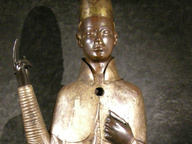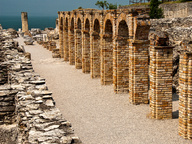Monk and Nannucci

Monk e Nannucci, Quartz Studio, Torino
From 08 Novembre 2014 to 24 Gennaio 2015
Turin
Place: Quartz Studio
Address: via Giulia di Barolo 18/d
Telefono per informazioni: +39 338 4290085
E-Mail info: info@quartzstudio.net
Official site: http://www.quartzstudio.net
On Saturday, November 8, 2014 at 7 pm, Quartz Studio is delighted to present the exhibition Monk>, a special project conceived specifically for the studio’s opening during the week of the Artissima art fair, with artists Jonathan Monk (Leicester, UK, 1969) and Maurizio Nannucci (Florence, Italy, 1939).
The exhibition's title includes the symbols for 'greater than' and 'less than,' which effectively visually connect the artists' last names, concisely mark their closeness and convey a sense of mutual exchange. The distance between the two artists' generation is reduced to nothing in the thoughtful reflection that each artist makes about the history of art through their work. Where Nannucci is minimal, precise, yet poetic, Monk is wry, witty, and sometimes unexpectedly caustic. As the artists themselves have noted, though their explorations run parallel in many aspects, they have interesting points of intersection. One such intersection is their referencing key figures of twentieth-century art like Alighiero Boetti. Boetti has come up as in Monk's work many times, sometimes explicitly or sometimes less so. Monk's many maps are a contemporary version of Boetti's original maps; his "self measurements" are, in essence, the offspring of the witty, classifying approach often seen in Boetti. And then there is Untitled and Unfinished (Afghanistan) from 2004,for which Monk made an expedition to the Band-e-Amir lakes in Afghanistan, where Boetti would have liked his ashes to have been scattered after his death.
As for Nannucci — from his incredible archives, containing personal memoirs as well as unique documents tracing his artistic path — he has said of Boetti, "With Alighiero, our references came from the same time, and we often surprised ourselves in how close they were and their intuitive similarities.” Nannucci's 'statements' are always mounted in structures that are extraordinary in historic, cultural and landscape senses, such as the Library of the German Parliament (2003), the Altes Museum in Berlin (2005), the Milan Triennale (2006), the historic Hubbrücke bridge in Magdeburg (2008), and the entrancing Medici villa La Magia in Quarrata (2009), just to name a few. In Nannucci's work, the relationship between the work of art and architecture — in the broadest sense of condensing cultural and structural marks — is an essential starting point, the distinguishing feature of his approach to his work and his mode of designing. His statements are always semantically open, while establishing themselves as universal and understood both mentally and emotionally by combining the message, font, size and color, all carefully devised by Nannucci for experiencing the art work in relationship to its context. The result is text and context that mutually reinforce each other. Nannucci's last solo show in Turin was in 1974 when he showed in Christian Stein's gallery, then in Piazza Vittorio. Since 1999, the sentence “All art has been contemporary” is proclaimed in blue at the entrance to GAM in Turin, forging a permanent bond between Nannucci and Turin. And Monk — who is from Britain— can consider himself at home in Turin too, as he has been collaborating since 2000 with gallerist Sonia Rosso. In 2009, on her invitation, Monk created the Lira Hotel (one of the names Alighiero Boetti had considered for his One Hotel in Kabul) where sleeping becomes an experience of full immersion in Monk's work as he 'decorated' a mini-apartment for the project at Via Giulia di Barolo 11.
The concept of authorship — a major force in Nannucci's work and often interrogated by Monk in a number of pieces wryly reworking works of others — is a basis for the dialogue between the two artists. For Quartz Studio, Monk and Nannucci created two neon works — Nannucci's preferred mode of expression and often used by Monk too. Both works, SOME WORDS WRITTEN BY SOMEONE ELSE FOR SOMEONE ELSE by Nannucci and Untitled (Via Luigi Santini, Roma)by Monk, are made in two different shades of blues and refer both in words and symbols to someone 'other' than themselves. In this intent to dialogue, the dynamic the two artists deploy is not limited merely to their identities; it opens to other subjects and forms of sharing, in a careful process of artistic reworking including the past and the present of eminent artists they knew, and the paradoxical identity behind anonymous street graffiti. Part of the osmotic design approach they implemented for Quartz Studio is the reworking of Manifesto (Poster), an Alighiero Boetti work from 1967 in which the last names of friends that Boetti had listed in the original are replaced by those chosen by Monk and Nannucci themselves, paired with other cryptic symbols.
The exhibition's title includes the symbols for 'greater than' and 'less than,' which effectively visually connect the artists' last names, concisely mark their closeness and convey a sense of mutual exchange. The distance between the two artists' generation is reduced to nothing in the thoughtful reflection that each artist makes about the history of art through their work. Where Nannucci is minimal, precise, yet poetic, Monk is wry, witty, and sometimes unexpectedly caustic. As the artists themselves have noted, though their explorations run parallel in many aspects, they have interesting points of intersection. One such intersection is their referencing key figures of twentieth-century art like Alighiero Boetti. Boetti has come up as in Monk's work many times, sometimes explicitly or sometimes less so. Monk's many maps are a contemporary version of Boetti's original maps; his "self measurements" are, in essence, the offspring of the witty, classifying approach often seen in Boetti. And then there is Untitled and Unfinished (Afghanistan) from 2004,for which Monk made an expedition to the Band-e-Amir lakes in Afghanistan, where Boetti would have liked his ashes to have been scattered after his death.
As for Nannucci — from his incredible archives, containing personal memoirs as well as unique documents tracing his artistic path — he has said of Boetti, "With Alighiero, our references came from the same time, and we often surprised ourselves in how close they were and their intuitive similarities.” Nannucci's 'statements' are always mounted in structures that are extraordinary in historic, cultural and landscape senses, such as the Library of the German Parliament (2003), the Altes Museum in Berlin (2005), the Milan Triennale (2006), the historic Hubbrücke bridge in Magdeburg (2008), and the entrancing Medici villa La Magia in Quarrata (2009), just to name a few. In Nannucci's work, the relationship between the work of art and architecture — in the broadest sense of condensing cultural and structural marks — is an essential starting point, the distinguishing feature of his approach to his work and his mode of designing. His statements are always semantically open, while establishing themselves as universal and understood both mentally and emotionally by combining the message, font, size and color, all carefully devised by Nannucci for experiencing the art work in relationship to its context. The result is text and context that mutually reinforce each other. Nannucci's last solo show in Turin was in 1974 when he showed in Christian Stein's gallery, then in Piazza Vittorio. Since 1999, the sentence “All art has been contemporary” is proclaimed in blue at the entrance to GAM in Turin, forging a permanent bond between Nannucci and Turin. And Monk — who is from Britain— can consider himself at home in Turin too, as he has been collaborating since 2000 with gallerist Sonia Rosso. In 2009, on her invitation, Monk created the Lira Hotel (one of the names Alighiero Boetti had considered for his One Hotel in Kabul) where sleeping becomes an experience of full immersion in Monk's work as he 'decorated' a mini-apartment for the project at Via Giulia di Barolo 11.
The concept of authorship — a major force in Nannucci's work and often interrogated by Monk in a number of pieces wryly reworking works of others — is a basis for the dialogue between the two artists. For Quartz Studio, Monk and Nannucci created two neon works — Nannucci's preferred mode of expression and often used by Monk too. Both works, SOME WORDS WRITTEN BY SOMEONE ELSE FOR SOMEONE ELSE by Nannucci and Untitled (Via Luigi Santini, Roma)by Monk, are made in two different shades of blues and refer both in words and symbols to someone 'other' than themselves. In this intent to dialogue, the dynamic the two artists deploy is not limited merely to their identities; it opens to other subjects and forms of sharing, in a careful process of artistic reworking including the past and the present of eminent artists they knew, and the paradoxical identity behind anonymous street graffiti. Part of the osmotic design approach they implemented for Quartz Studio is the reworking of Manifesto (Poster), an Alighiero Boetti work from 1967 in which the last names of friends that Boetti had listed in the original are replaced by those chosen by Monk and Nannucci themselves, paired with other cryptic symbols.
SCARICA IL COMUNICATO IN PDF
COMMENTI

-
 Dal 31 gennaio 2024 al 04 maggio 2025
Fermo | Palazzo dei Priori
Dal 31 gennaio 2024 al 04 maggio 2025
Fermo | Palazzo dei Priori
-
 Dal 20 dicembre 2024 al 04 maggio 2025
Fermo | Palazzo dei Priori
Dal 20 dicembre 2024 al 04 maggio 2025
Fermo | Palazzo dei Priori
-
 Dal 20 dicembre 2024 al 04 maggio 2024
Gorizia | Palazzo Attems Petzenstein
Dal 20 dicembre 2024 al 04 maggio 2024
Gorizia | Palazzo Attems Petzenstein
-
 Dal 18 dicembre 2024 al 18 dicembre 2024
Venezia | Museo Correr
Dal 18 dicembre 2024 al 18 dicembre 2024
Venezia | Museo Correr
-
 Dal 14 dicembre 2024 al 02 marzo 2025
Palermo | Palazzo Abatellis
Dal 14 dicembre 2024 al 02 marzo 2025
Palermo | Palazzo Abatellis
-
 Dal 12 dicembre 2024 al 23 febbraio 2025
Roma | Palazzo Altemps
Dal 12 dicembre 2024 al 23 febbraio 2025
Roma | Palazzo Altemps


